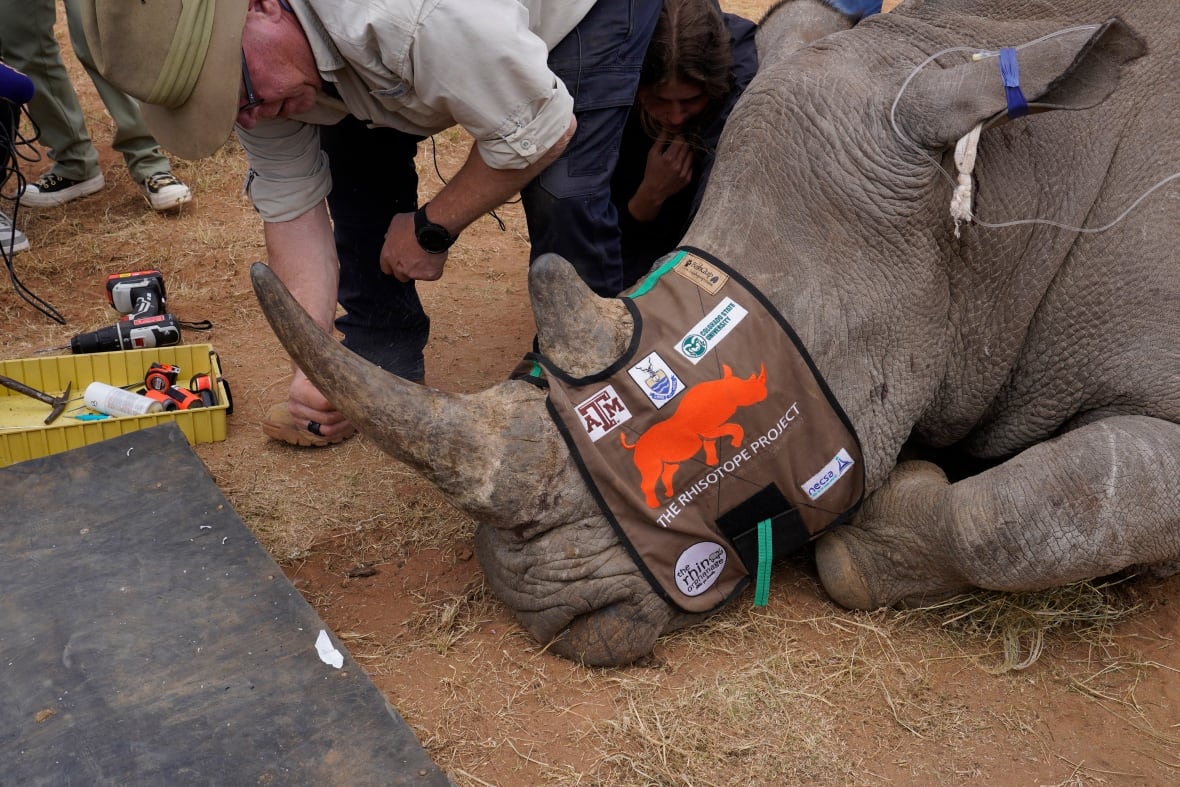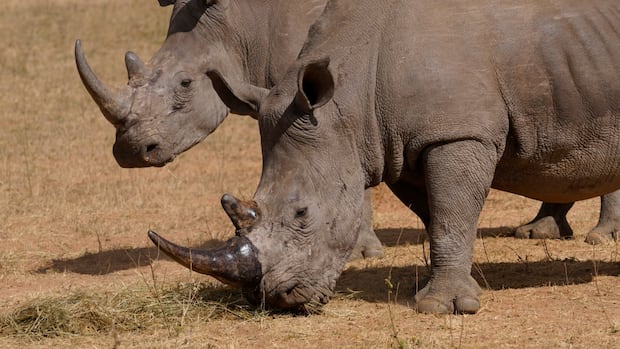As it happensEnvironmentalists give radioactive horns to rhinos to save them from poachers
Injection of radioactive isotopes into the horns of live rhino is much easier than it sounds, says James Larkin.
“You generally drill a hole in the horns, place a carefully selected radio isotope in the horns in several places, then seal it, you turn the calming and send the rhino on the way in the next five years,” he told As it happens Host Guest Paul Hunter.
“It’s easy. It’s all ready and dust in a few minutes.”
Larkin is the Chief Scientific Officer of the Rhisotope project, which aims to defend the critically endangered rhinos of South Africa by making his horns radioactive.
According to him, they are too weak to pose some risk to animals, but strong enough to put alarms as a nuclear security system for international border crossings. The goal is to deter people to poaching rhinos and to catch those who do it.
Scientists who do not participate in the project welcome innovative efforts to protect critically endangered animals, but emphasize that this work itself is not enough to save them.
Low doses turned out to be safe in test
The Rhisotope Project project is a collaboration between nuclear and environmentalists employees, in partnership with the International Atomic Energy Agency (IAEA) and the University of South Africa of Whitvatersran, where Larkin is the director of the Radiation and Health Physics Department.
“When I saw enough these videos of animal mutilation … I came to me, hey, I might be able to do something about it using my origin,” he said.
First, he says, they had to make sure they were working and they were safe for rhino.
Thus, over the last six years, he and his colleagues have been testing the idea, first in the computational modeling laboratory, to determine the most secure effective dose, and later in the field where they inject 20 black and white rhinos into the Rhino orphan Limpopo province in South Africa.
The monitoring studies of rhinos, according to him, show no negative effects of radiation, which he believes are the human equivalent of receiving three CT scans a year.
“No, it won’t hurt the animals and, no, they will not shine in the dark.” said Larkin.

However, radiation is strong enough to give up radiation detectors at airports and other border crossings.
“Over the years, due to the threat of nuclear terrorism, these detectors have been installed around the world in ports, airports and such places to stop the illegal movement of radioactive materials,” Larkin said.
“So we stand on the shoulders of this in many ways. Systems are there. Operational procedures are there. So we just said: Let’s use this to help reduce the horn traffic of the rhino.”
The goal, according to him, is not only to catch people to carry the horns, but also to deter other poachers to even bother to try.
“Using an already installed nuclear security infrastructure in new ways, we can help protect one of the most emblematic and endangered species in the world.”
Maaer Director General Mariano Grossi said the project shows how nuclear science “can be used in new ways to deal with global challenges.”
“Using the already installed nuclear security infrastructure in new ways, we can help protect one of the most emblematic and endangered species in the world,” he is said in a press release of the United Nations.
This is one of several new approaches to protecting Rhino in recent years. A study published last year also showed that Rhino decoration reduced poaching by 78 % over a seven -year period of eight reserves.
Disposition does not affect the health or ability of animals to reproduce, but A survey of 2023 found that this could affect their behaviorBy causing them to socialize less and reduce the size of their home ranges.
Hundreds of rhinos killed each year
The Rhisotope project has injected five rhinos so far outside the original test group, but they hope that their work will lead to mass injections across the country. They encourage private owners of wildlife parks and national conservation bodies to sign.
The International Nature Protection Union estimates that the global rhino population was around 500,000 in the early 20th century, but is now decreasing to about 27,000 due to the continued demand for the horns of the Black Market Rhinog.
South Africa has the largest population of rhinos with approximately 16,000, but the country is experiencing high levels of poaching with about 500 rhinos killed for their horns each year.
Larkin says the rhino can bring up to $ 60,000 ($ 82,000 CDN) to the Black Market. It is sometimes used in traditional drugs in Asian countries, but Larkin says their main goal is a symbol of wealth and status.
“Nowadays, this is able to show your friends and business colleagues to be honest,” he said.
Berger says he hopes this method will be adapted to protect other highly poachers and says he is already in talks with environmentalists who work to protect elephants who are poachers for their horns, and Paglini who are hunting for their scale.

Joel Berger, an ecologist of wildlife at Colorado State University, who does not participate in the project, welcomes the initiative.
“After studying the black and white rhino in South Africa, watching the scary fee for poaching, now – about 30 years later – it is incredibly exciting that new technologies are being tested to try to thwart illegal trade,” Berger told CBC in email.
“The use of radioactive isotopes implanted in the horns to improve the discovery of smuggling horns across borders, it offers the hope of filming greedy marketers of world innocent icons.”
However, he says, it is not enough in itself to save rhinos. Authorities also need to break up on criminal networks that maintain the marcore of horns alive, he said.
https://i.cbc.ca/1.7599961.1754077990!/cpImage/httpImage/image.jpg_gen/derivatives/16x9_1180/south-africa-radioactive-rhino-horns.jpg?im=Resize%3D620
2025-08-01 21:25:49

